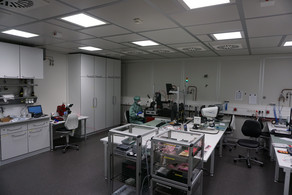Alle Neuigkeiten
Enhancement of Proton Therapy Efficiency by Noble Metal Nanoparticles Is Driven by the Number and Chemical Activity of Surface Atoms
- Veröffentlichungen

Abstract:
Proton-based radiotherapy is a modern technique for the treatment of solid tumors with significantly reduced side effects to adjacent tissues. Biocompatible nanoparticles (NPs) with high atomic numbers are known to serve as sensitizers and to enhance treatment efficacy, which is commonly believed to be attributed to the generation of reactive oxygen species (ROS). However, little systematic knowledge is available on how either physical effects due to secondary electron generation or the particle surface chemistry affect ROS production. Thereto, ligand-free colloidal platinum (Pt) and gold (Au) NPs with well-controlled particle size distributions and defined total surface area are proton-irradiated. A fluorescence-based assay is developed to monitor the formation of ROS using terephthalic acid as a cross-effect-free dye. The findings indicate that proton irradiation (PI)-induced ROS formation sensitized by noble metal NPs is driven by the total available particle surface area rather than particle size or mass. Furthermore, a distinctive material effect with Pt being more active than Au is observed which clearly indicates that the chemical reactivity of the NP surface is a main contributor to ROS generation upon PI. These results pave the way towards an in-depth understanding of the NP-induced sensitizing effects upon PI and hence a well-controlled enhanced therapy.
Zur Veröffentlichung:
Small 2021, 2106383
Unsere weiteren Veröffentlichungen zum Thema Protonentherapie finden sie auf der zugehörigen Publikationsliste.





